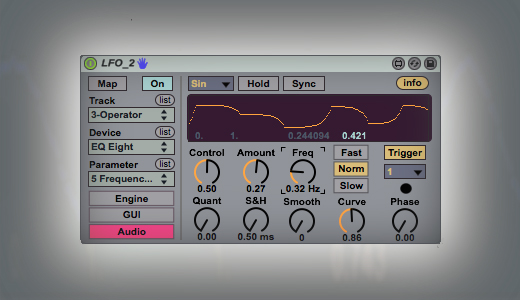LFO 2.0 is the result of trying to build the best general purpose swiss knife LFO for myself. It needs Ableton Live 9.x with Max4Live installed.
It offers three basic ways of modulating a target: Directly via Live's engine, (Engine) which disables manual control of the target parameter and is perfect for fast modulations. Or via a method similar to manually turning a knob on the user interface (GUI), which can create automation data when recording.And, as a third mode it can put out the modulation as audio signal (Audio) which is useful for creating control voltages for analog synthesizers.
Assigning the LFO to a modulation target is simple: Press Map to activate the automatic target detection and click on the target parameter. The Map button should turn off and the parameter should appear in the Track, Device, Parameter choosers. Alternatively one can of course navigate with those choosers to the desired parameter. The LFO modulation of the parameter can be (temporarily) disabled via the On button.
The LFO offers several waveforms: Sine, Ramp Up, Ramp Down, Square, Stepped Random, Smooth Random, and Binary Random.When assigning the LFO to a target, the target parameter's previous value is taken over by the Control parameter. The Amount control defines the depth of the LFO modulation centered around the Control value. The LFO covers a very large frequency range from extremely slow (several minutes for a cycle) to audio rate. The frequency is controlled by the Freq knob plus the Slow,Norm,Fast radio button.
The LFO rate is intentionally never hard-synced to beat time, because I find it boring. However, there is a Trigger mode which allows to reset the LFO wave in beat time intervals. The Phase control allows to define where in the waveform cycle the LFO restarts. Hold allows to temporarily stop the LFO at the current value. When Hold is turned off, the LFO continues where it was stopped.There are several ways to modify the output of the LFO: Quant: introduces steps in the amplitude of the LFO, which is interesting e.g. when modulating the Coarse frequency of an oscillator in Operator via the Engine. Setting the Quant parameter to 1 creates integer steps, just like turning the knob manually, whilst a Quant of 0 creates continuous changes. Note that in GUI mode the Coarse parameter of Operator is stepped regardless of the Quant setting.
The sample and hold (S&H) parameter allows to sample the LFO signal in regular intervals, which creates stepped waves in time. This parameter can also be set in beat time intervals by pressing the Sync button.Smooth creates soft transitions between hard edges of waveforms and Curve shifts the center of the wave, thus creating asymmetrical modulations. Smooth and Curve are applied at the end of the signal chain, after the sample and hold and quantization process.
LFO 2.0 is available for free!However, if you find it useful, I would appreciate an email with some feedback or a link to your music.
DOWNLOAD : Link
